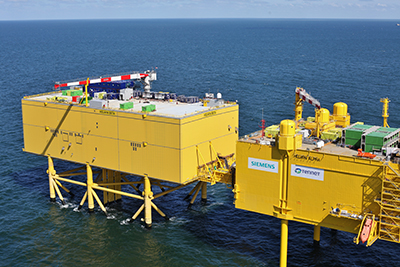Siemens hands over fourth North Sea grid connection HelWin2 to TenneT

With HelWin2, Siemens has handed over the fourth North Sea grid link to the customer TenneT. This marks the start of commercial operation of the grid connection by the German-Dutch transmission grid operator. All in all, there are now four Siemens grid links with a transmission capacity of over 2.9 gigawatts (GW) installed in the North Sea which together are capable of supplying around four million German households with electricity.
The offshore platform HelWin2 alone, which has just gone online, can transmit up to 690 megawatts (MW) of green electricity, enough to supply nearly 900,000 German households. The offshore platform of the HelWin2 link is located about 85 kilometers off the northwest coast of the island of Helgoland from which it takes its name. The connected wind farm will be successively expanded and connected with Siemens wind turbines of the 3.6 megawatt class, with additional turbines being linked in practically every day.
“This year we've completed the first four offshore grid links of this performance class in the world using efficient direct current technology. Thanks to Siemens technology, nearly four million German households can be supplied with wind power generated offshore,” said Tim Dawidowsky, CEO of the Transmission Solutions business unit within the Siemens Energy Management Division.
“The completion of HelWin2 marks an important milestone for us. Step by step we are implementing the offshore development goals set by the German government”, declared Lex Hartman, member of the managing board of TenneT. “The goal of the German government is to have 6.5 gigawatts of offshore wind power capacity installed by 2020. TenneT has already achieved more than 50 percent of this target.”
Transmission grid operator TenneT awarded the consortium consisting of Siemens and Italian cable specialist Prysmian the order to deliver the offshore grid links for HelWin1 (576 MW) and HelWin2 (690 MW) off Helgoland, BorWin2 (800 MW) off Borkum and SylWin1 (864 MW) off Sylt. All four North Sea grid links are now in normal operation and transporting electricity generated out at sea onto land with low losses.
Siemens received its latest order for a grid connection in the North Sea, BorWin3, in the spring of 2014 in a consortium with Petrofac. This fifth Siemens grid link is due to go into commercial operation in 2019. After it is commissioned, the five installed Siemens network grids will have a total transmission capacity of 3.8 gigawatts and will transport offshore wind power for supplying theoretically nearly five million households.
Thanks to the Siemens high-voltage direct-current (HVDC) technology, transmission losses for each grid connection, including cable losses, are less than four percent. This Siemens HVDC technology is installed on the offshore platforms and in the land-based converter stations. The wind-based electricity is transmitted as alternating current to the converter platform, transformed into direct current and fed to the mainland via a subsea cable. The land-based station converts the direct current back into alternating current and feeds the electricity into the extra-high voltage grid. HVDC is the only efficient transmission solution for cable lengths of more than 80 kilometers.
The HVDC Plus technology used by Siemens is less complex and extremely compact, making it predestined for use in sea-based applications. In contrast to classic HVDC technology used in a vast majority of land links, systems equipped with HVDC Plus feature self-stabilization. As fluctuations in the grid must always be reckoned with for wind-based power generation, grid stability and reliability is enhanced considerably through the use of the Siemens HVDC Plus technology.
This press release and a press picture is available at www.siemens.com/press/x-win
For further information on Energy Management, please see www.siemens.com/energy-management
Siemens AG (Berlin and Munich) is a global technology powerhouse that has stood for engineering excellence, innovation, quality, reliability and internationality for more than 165 years. The company is active in more than 200 countries, focusing on the areas of electrification, automation and digitalization. One of the world's largest producers of energy-efficient, resource-saving technologies, Siemens is No. 1 in offshore wind turbine construction, a leading supplier of combined cycle turbines for power generation, a major provider of power transmission solutions and a pioneer in infrastructure solutions as well as automation, drive and software solutions for industry. The company is also a leading provider of medical imaging equipment – such as computed tomography and magnetic resonance imaging systems – and a leader in laboratory diagnostics as well as clinical IT. In fiscal 2014, which ended on September 30, 2014, Siemens generated revenue from continuing operations of €71.9 billion and net income of €5.5 billion. At the end of September 2014, the company had around 343,000 employees worldwide on a continuing basis.
Further information is available on the Internet at www.siemens.com
Reference Number: PR2015060251EMEN
Contact
Mr. Stefan Wagner
Siemens AG
Otto-Hahn-Ring 6
81739 Munich
Germany
Tel: +49 (89) 636632041
sw.wagner@siemens.com
Ms. Sabrina Martin
Energy Management Division
Siemens AG
Freyeslebenstr. 1
91058 Erlangen
Germany
Tel: +49 (9131) 18-7032
sabrina.martin@siemens.com
All latest news from the category: Corporate News
Newest articles

You are What You Eat—Stanford Study Links Fiber to Anti-Cancer Gene Modulation
The Fiber Gap: A Growing Concern in American Diets Fiber is well known to be an important part of a healthy diet, yet less than 10% of Americans eat the minimum recommended…

Trust Your Gut—RNA-Protein Discovery for Better Immunity
HIRI researchers uncover control mechanisms of polysaccharide utilization in Bacteroides thetaiotaomicron. Researchers at the Helmholtz Institute for RNA-based Infection Research (HIRI) and the Julius-Maximilians-Universität (JMU) in Würzburg have identified a…

ASXL1 Mutation: The Hidden Trigger Behind Blood Cancers and Inflammation
Scientists show how a mutated gene harms red and white blood cells. LA JOLLA, CA—Scientists at La Jolla Institute for Immunology (LJI) have discovered how a mutated gene kicks off…



